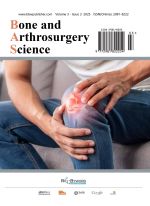Clinical Application of “Three-in-One” Bone Repair Strategy in the Perioperative Period of Elderly Intertrochanteric Femoral Fractures
Abstract
Objective: To investigate the clinical value of the “three-in-one” bone repair strategy (perioperative anti-osteoporosis therapy, optimization of minimally invasive intramedullary fixation technology, and postoperative intervention of Shenqi Hexue Decoction) in the treatment of elderly intertrochanteric femoral fractures. Methods: We retrospectively analyzed the elderly patients with intertrochanteric femoral fracture and intramedullary nail fixation admitted from January 2022 to December 2024, and divided the patients into two groups according to the method of this study: control group (63 cases, routine intramedullary fixation and basic anti-osteoporosis therapy) and trinity group (63 cases, using the “three-in-one” strategy). The perioperative indexes, bone metabolism indexes (BALP, BGP, PICP, PINP), Harris hip score, complications, and 1-year survival rate were compared between the two groups. Results: The intraoperative blood loss (95.3 ± 15.2 mL) and hospital stay (9.8 ± 2.1 days) in the trinity group were significantly lower than those in the control group (128.7 ± 20.1 mL and 14.5 ± 3.6 days, respectively) (P < 0.01). Six weeks after surgery, the levels of bone formation markers BALP (25.1 ± 3.8 U/L) and PICP (125.6 ± 18.3 μg/L) in the trinity group were significantly higher than those in the control group (P < 0.05). At 12 weeks after operation, the Harris score (86.7 ± 6.4) was significantly better than that of the control group (78.2 ± 7.1) (P < 0.01). Compared with the control group (14.7 ± 2.3 weeks), the fracture healing time in the trinity group (11.2 ± 1.8 weeks) was shortened by 23.8%, and the incidence of deep vein thrombosis (4.8% vs 15.9%) was significantly reduced (P < 0.05). Conclusion: The “three-in-one” strategy optimizes perioperative management, promotes bone metabolism and fracture healing, rapidly improves hip joint function, and reduces complications through multi-target intervention. It is a safe and effective solution for intertrochanteric fractures in the elderly, and is worthy of clinical application.
References
Che SH, Cho MR, Quinn PM, et al., 2023, Risk Factors Affecting Hip Fracture Patterns in an Elderly Korean Patient Population. Medicine (Baltimore), 102(33): e34573.
Whitehead K, Spaner D, 2018, Management of Traumatic Hip Fracture in the Palliative Care Unit. J Palliat Care, 33(3): 175–177.
Hu Q, Wang Q, Liu F, et al., 2022, Combination of Calcitriol and Zoledronic Acid on PINP and β-CTX in Postoperative Patients with Diabetic Osteoporosis: A Randomized Controlled Trial. Disease markers, 2022: 6053410.
Miller ND, Cho T, Gokula L, et al., 2025, Intertrochanteric Fractures in the Elderly Treated with Different Intramedullary Devices: A Systematic Review and Meta-Analysis Based on Comparison Studies. JBJS Rev, 13(3).
Youth Osteoporosis Study Group of Chinese Orthopaedic Association, Trauma Orthopedics and Multiple Injuries Study Group of Emergency Resuscitation Professional Committee of Chinese Medical Doctor Association, Osteoporosis Professional Committee of Shanghai Association of Integrative Medicine, 2018, Chinese Expert Consensus on Perioperative Management of osteoporotic Fractures (2018). Chinese Journal of Clinical Medicine, 25(5): 860–866.
Hagen MS, Allahabadi S, Zhang AL, et al., 2020, A Randomized Single-Blinded Trial of Early Rehabilitation Versus Immobilization After Reverse Total Shoulder Arthroplasty. J Shoulder Elbow Surg, 29(3): 442–450.
Chen X, Hu Y, Su J, 2024, Application of the “Trinity” Bone Repair Strategy in Osteoporotic Fractures. Chinese Journal of Trauma, 39(06): 494–499.
Wan Q, Zou C, Yi H, et al., 2022, Application of Shenqi Hexue Decoction in Postoperative Rehabilitation of Orthopedic Diseases. Chinese Ethnic Medicine and Ethnomedicine, 31(19): 82–84.
Desai SM, Bernhard WN, McAlary B, 1990, Regional Anesthesia: Management Considerations in the Trauma Patient. Crit Care Clin, 6(1): 85–101.
US Preventive Services Task Force, Curry SJ, Krist AH, et al., 2018, Screening for Osteoporosis to Prevent Fractures: US Preventive Services Task Force Recommendation Statement. JAMA, 319(24): 2521–2531.
Hamid M, Liu D, Abdulrahim Y, et al., 2017, Amelioration of CCl4-Induced Liver Injury in Rats by Selenizing Astragalus Polysaccharides: Role of Proinflammatory Cytokines, Oxidative Stress and Hepatic Stellate Cells. Research in Veterinary Science, 114: 202–211.
Erseckin V, Mert H, Irak K, et al., 2022, Nephroprotective Effect of Ferulic Acid on Gentamicin-Induced Nephrotoxicity in Female Rats. Drug Chem Toxicol, 45(2): 663–669.
Ekhtiar M, Ghasemi-Dehnoo M, Azadegan-Dehkordi F, et al., 2025, Evaluation of Anti-Inflammatory and Antioxidant Effects of Ferulic Acid and Quinic Acid on Acetic Acid-Induced Ulcerative Colitis in Rats. J Biochem Mol Toxicol, 39(2): e70169.
Kukla C, Heinz T, Gabler C, 1995, Acute Management of Para-Articular Hip Fractures in Geriatric Patients. Wien Klin Wochenschr, 107(5): 169–174.
Verbeek DO, Ponsen KJ, Goslings JC, et al., 2008, Effect of Surgical Delay on Outcome in Hip Fracture Patients: A Retrospective Multivariate Analysis of 192 Patients. Int Orthop, 32(1): 13–18.
Cao L, Chen X, Weng W, et al., 2017, Surgical Treatment Strategy Selection for Hip Fracture Patients Over 80 Years Old: A Report of 915 Cases. Academic Journal of Second Military Medical University, 38(04): 409–414.
Liu Z, Lv X, Liu J, et al., 2020, Epidemiological Characteristics of 2342 Hip Fracture Cases: A Single-Center Analysis. Chinese Journal of Tissue Engineering Research, 24(32): 5085–5091.
Ye J, Wei D, Peng L, et al., 2019, Ginsenoside Rb1 Prevents Steroid Induced Avascular Necrosis of the Femoral Head Through the Bone Morphogenetic Protein 2 and Vascular Endothelial Growth Factor Pathway. Mol Med Rep, 20(4): 3175–3181.
Chen F, Dai Z, Kang Y, et al., 2016, Effects of Zoledronic Acid on Bone Fusion in Osteoporotic Patients After Lumbar Fusion. Osteoporos Int, 27(4): 1469–1476.
Zhang J, Zhao R, Hou G, et al., 2023, Stereoscopic Differences in the Identification, Bioactivity, and Metabolism of C-20 and C-24 Epimeric Ginseng Saponins. Mini Rev Med Chem, 23(7): 804–820.

